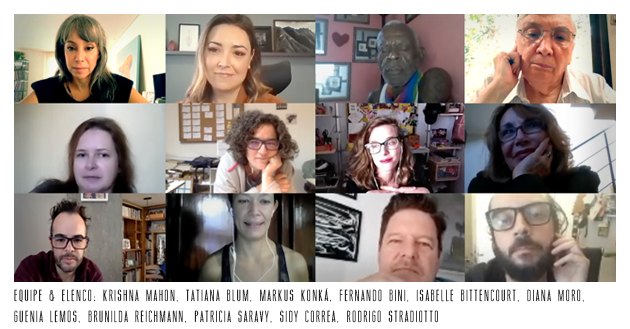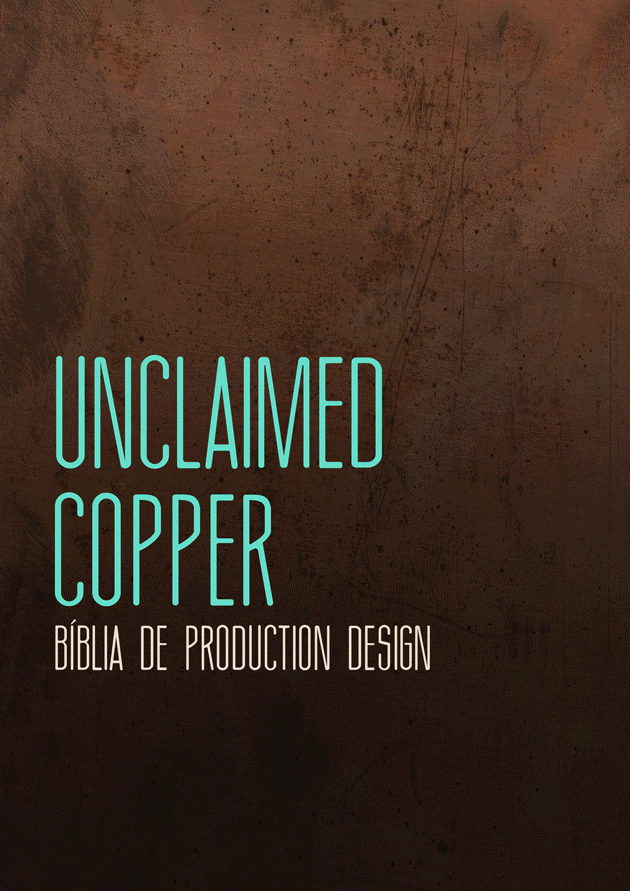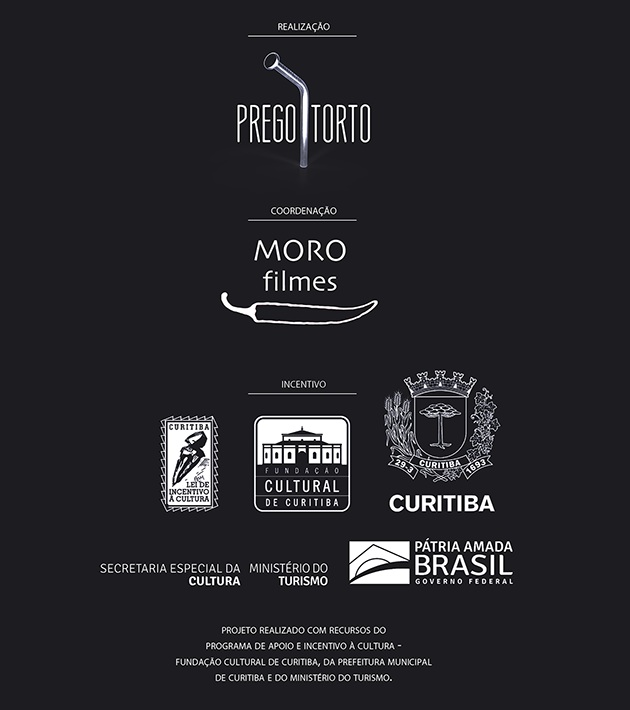
UNCLAIMED COPPER é um projeto de longa-metragem desenvolvido pela Prego Torto em parceria com a Moro Filmes. Incentivo da Fundação Cultural de Curitiba, da Prefeitura Municipal de Curitiba e do Ministério do Turismo. Interessados na visualização do roteiro e bíblia de production design podem enviar uma email para diana@morocom.com.br para recebimento de uma cópia em pdf. |
|||
UNCLAIMED COPPER is a feature-length project developed by Prego Torto in partnership with Moro Filmes. Incentive by Cultural Foundation of Curitiba, City of Curitiba and MInistery of Tourism. People interested in visualizing the script and production design bible may send an email to diana@morocom.com.br to receive a pdf copy. |
|||

Num futuro antigo, superpopuloso e distópico, Iori é uma solitária funcionária pública encarregada de arquivar urnas de recém falecidos inadimplentes com suas taxas de cremação. Notando que algumas urnas aparentam ter sido esvaziadas, Iori descobre a existência de um mercado clandestino de cinzas humanas. Ao mesmo tempo, Iori é tomada por um resquício de encanto possível nas relações humanas com duas pessoas que moram em seu prédio: o zelador octogenário que dança sozinho no porão de madrugada; e uma criança misteriosa, vizinha de seu andar, que fica órfã. |
|||
In a dystopic and overcrowded ancient future, Iori is a lonely public servant in charge of archiving urns for the recently deceased defaulters of their cremation fees. Noticing that some urns appear to have been emptied, Iori discovers the existence of a clandestine market for human ashes. At the same time, Iori is taken by a vestige of beauty capable of existing in human relationships with two people who live in her building: the octogenarian superintendent, who dances alone in the basement at night; and a mysterious child, her floor neighbor, who becomes an orphan. |
|||
| Roteiro | Guenia Lemos |
| Produção | Diana Moro |
| Produção Executiva | Gianna Coelho |
| Sound Design & Trilha | Rodrigo Stradiotto |
| Production Design | Isabelle Bittencourt |
| Consultoria de História da Arte | Fernando Bini |
| Consultoria de Roteiro | Krishna Mahon |
| Tradução | Brunilda Reichmann |
| Edição | Gabriel Gorosito |
| Elenco da Leitura | Patrícia Saravy, Markus Konká, Gabriel Gorosito, Sidy Correa e |
| Tatiana Blum | |
| Incentivo | Fundação Cultural de Curitiba, Prefeitura Municipal de Curitiba e |
| Ministério do Turismo | |
| Coordenação | Moro Filmes |
| Realização | Prego Torto |
 |
| Video Teaser de UNCLAIMED COPPER | ||
| Video Teaser of UNCLAIMED COPPER | ||
| Leitura Editada do roteiro longa metragem UNCLAIMED COPPER (30") | ||
| Edited reading of the feature-length script UNCLAIMED COPPER (30") | ||
| Processo de criação de UNCLAIMED COPPER - Reunião de ARTE 1 | ||
| Process of creating UNCLAIMED COPPER - ART 1 | ||
| Processo de criação de UNCLAIMED COPPER - Reunião de ARTE 2 | ||
| Process of creating UNCLAIMED COPPER - ART 2 | ||
| Processo de criação de UNCLAIMED COPPER - Reunião de SOM | ||
| Process of creating UNCLAIMED COPPER - SOUND | ||
| Processo de criação de UNCLAIMED COPPER - Reunião de HISTÓRIA DA ARTE | ||
| Process of creating UNCLAIMED COPPER - HISTORY OF ART | ||
| Processo de criação de UNCLAIMED COPPER - Reunião de ROTEIRO 1 | ||
| Process of creating UNCLAIMED COPPER - SCRIPT 1 | ||
| Processo de criação de UNCLAIMED COPPER - Reunião de ROTEIRO 2 | ||
| Process of creating UNCLAIMED COPPER - SCRIPT 2 | ||
| DECLARAÇÃO DA DIRETORA & ROTEIRISTA | |||
| DECLARATION BY SCRIPT WRITER & DIRECTOR | |||
A inspiração do longa-metragem UNCLAIMED COPPER surgiu a partir de uma foto de um depósito localizado no Hospital Estadual de Oregon, nos EUA. Nesse depósito há prateleiras repletas de urnas de cobre velho já cobertas com verdete. Dentro de cada uma dessas urnas estão cinzas de pacientes falecidos que nunca foram resgatadas por nenhum familiar. Pode parecer descartável, mas a foto inspirou reflexão naquele momento: imagina uma vida tão solitária que ninguém nem mesmo se sinta no dever de buscar suas cinzas quando você falecer. A solidão poderia estar no topo da lista dos grandes males do século. Estamos mais do que nunca conectados uns aos outros em redes que criam uma falsa sensação de comunidade e, ao mesmo tempo, lentamente perdendo a vontade de nos conectarmos ao vivo. Telas e mais telas nos roubam a atenção, e quando tiramos os olhos delas por um instante para olhar o mundo ao nosso redor muitas vezes nos deparamos apenas com um grande vazio. Buscamos soluções imediatistas e paliativas para tapar esses buracos e que, por fim, só nos afundam ainda mais em um caminho muitas vezes de mão única. Drogas, religião, consumo, tudo vira moeda de troca nesse marketing desenfreado do capitalismo e da vida moderna. No entanto, ainda existe muita poesia para ser encontrada no meio dessa solidão e caos - assim como os espaços negativos em volta de uma obra de arte realçam sua importância, o caos pode nos fazer captar a integridade e beleza das coisas mais simples com mais facilidade. E esses momentos são transformadores. Pode ser em uma criança que te olha como se já te conhecesse há vidas. Pode ser em um toque, mesmo que de uma máquina, mas que imita um toque humano há tempos não sentido. Pode ser em uma pessoa, que, mesmo sozinha, dança com um parceiro feita com as mangas de uma camisa pendurada no teto. UNCLAIMED COPPER parte dessa premissa de um mundo caótico com uma superpopulação solitária afundada no consumo de fé e drogas para criar uma distopia sediada em um futuro antigo: nesse mundo é como se 70 anos atrás a tecnologia tivesse tomado outro rumo e existisse hoje um futuro com cara de passado. O roteiro se inicia já no centenário do Decreto do Filho Único, quando as pessoas não têm mais familiaridade alguma com simples parentescos como irmãos, irmãs, primos e tios. Nesse contexto, as constantes telas que existem por todos os lados ajudam a suprir as lacunas emocionais de cada um: dessensibilizando, (re)programando e robotizando cada indivíduo de acordo com o julgamento das pessoas que detêm o poder. Apesar de toda temática distópica, beirando ao apocalíptico, e talvez por conta disso, o roteiro tem como inspiração mor o tom de “Brazil, o filme” de Terry Gilliam (1985), com sua linguagem absurda e dead-pan britânico que casa o horror e o humor em proporções equivalentes. Cenas tragicômicas entrecortam esse mundo sem sentido e que não aparenta ter qualquer tipo de solução que venha a fazer sentido para os personagens em momento algum. Resta apenas aceitar a condição humana tal como ela é, como diz Martin Esslin, enfatizando que o “absurdo não provoca lágrimas de desespero, mas risos de libertação”. Entretanto, para a nossa protagonista Iori, resta também a possibilidade de viver mais atenta e aberta aos acontecimentos à sua volta - assim como causar um pouco de ruptura saudável, sempre que possível, no sistema. Nessa sociedade que caminha cada vez mais para o distanciamento das relações humanas, onde o desencanto pelo mundo e pelos outros é palpável, e as pessoas se mantem grudadas às suas telas e seus vícios sem notar ou se importar com o caos em sua volta, Iori se sente tão sozinha que compra uma máquina chamada “afagador” que acopla em cima de sua cama de solteira para lhe fazer carinho. E é a chegada dessa máquina, ou desse toque, que é o ponto inicial na transformação de Iori - que a conecta com a criança quando a máquina ainda está na caixa na frente do seu apartamento; que a faz quebrar sua tela portátil e notar o mundo em sua volta; que a leva até o quarto onde Manassés dança no porão quando vai descartar a embalagem; que a impulsiona para querer e tentar algo diferente. Sem sua tela portátil, Iori começa a enxergar o mundo ao seu redor. Repara o orfanato enjaulado. Repara crianças sendo levadas por policiais. Repara o corpo da mendiga com suas erupções alérgicas na pele. Repara quando essa mendiga começa a cantar a ária Nessun Dorma, da ópera Turandot de Puccini, em uma sequência que logo vira uma cantoria estilo flashmob, em um dos momentos trip sequence do roteiro, de desconexão com a realidade (muito como Almodóvar faz na cena de cinema mudo dentro do seu filme “Fale com ela”). A ópera de Puccini tem especial relação com o roteiro visto que cada uma das respostas das charadas postas pela princesa Turandot (a quem ouse o desafio de desvendá-las e casar com ela, ou morrer) estão conectadas aos 3 personagens principais do roteiro: a criança é a esperança em forma de fantasma, Manassés é o sangue representado pelo vestido vermelho, e Iori é a própria princesa Turandot, um gelo que pega fogo. O retrato no roteiro é obviamente de uma grande hipérbole catastrófica dos nossos tempos atuais, da superpopulação à desconexão entre as pessoas, dos olhos que vivem grudados em telas à falta de empatia generalizada, da desgraça como entretenimento ao descaso com as incontáveis vítimas do mundo das drogas. Porém, ele não deixa de pôr em xeque a máquina de manipulação do povo que existe por trás de grandes instituições antiéticas que ditam regras obscuras mundo afora: governos fascistas, grupos religiosos corruptos, grandes indústrias com seus marketings agressivos e redes de comunicação mal-intencionados. E, no universo de UNCLAIMED COPPER, esses quatro grupos encontram-se todos em uma relação promíscua um com o outro. UNCLAIMED COPPER é uma história que visa apontar hipocrisias do nosso mundo moderno sem panfletar soluções, até mesmo porque se existem soluções para todos esses nossos dilemas, nós provavelmente não vamos decifrá-los, como o próprio drama do absurdo já nos alertou. Mas essa busca de um modo de operação de vida e de convivência no mundo, que leve em conta o bem coletivo, deve ser um dos eternos objetivos da cultura e da arte. Parece ser uma tarefa impossível, mas de história em história atinge-se uma pequena fatia de público e, de uma forma ou de outra, este público se reconfigura. Em UNCLAIMED COPPER os arquétipos do feminino, do idoso e do infantil se encontram, se estranham, inicialmente, mas eventualmente se acolhem. É um roteiro que lida com questões urgentes de conectividade humana e propósito de vida mesmo em um mundo sem sentido. De como um simples toque de carinho, mesmo que vinda de uma máquina, leva a uma troca de olhares e uma escuta atenta que é capaz de criar energia suficiente para desestabilizar um sistema opressor por um breve momento. Imagine então do que seria capaz um verdadeiro toque humano nesse universo. |
|||
|
The inspiration for the feature film UNCLAIMED COPPER came from a photo of a warehouse located at the Oregon State Hospital, USA. In this warehouse there are shelves full of copper urns covered with verdigris. Inside each of these urns are the ashes of deceased patients who were never claimed by any family member. It might look disposable, but the photo inspired reflection at that moment: imagine a life so lonely that no one even feels the duty to claim your ashes when you pass away. Loneliness could top the list of the greatest evils of the century. We are more than ever connected to each other in networks that create a false sense of community while slowly losing the urge to connect in real life. Screens and more screens steal our attention, and when we stop to take our eyes off them for a moment and notice what is in front of us, we often find ourselves faced with nothing but a great emptiness. We seek immediate and palliative solutions to fill these holes, which ultimately only sink us further down a path that is often one-way. Drugs, religion, consumption, everything becomes a bargaining chip in this unbridled marketing of capitalism and modern life. But there is a lot of poetry to be found in the midst of this loneliness and chaos. Just as the negative spaces around a work of art emphasize its importance, chaos can often make us capture the integrity and beauty of the simplest things more easily. And these moments are transformative. It could be a child who looks at you as if she has known you for lifetimes. It can be a touch, even if done by a machine, but that imitates a human touch that has not been felt for a while. It can be in a person who, even if alone, dances with a partner made with the sleeves of a shirt hanging from the ceiling. UNCLAIMED COPPER starts from this premise of a chaotic world with an overpopulation of lonely people sunk in the consumption of faith and drugs to create a dystopia set in an ancient future: in this world it is as if 70 years ago technology had taken a different direction and there was today a future that looked a little bit like the past. The script begins at the centenary of the Decree of the Only Child, when people are no longer familiar with simple kinships such as brothers, sisters, cousins and uncles. In this context, the constant screens that exist everywhere help to fill everyone’s emotional gaps: desensitizing, (re)programming and robotizing each individual according to the judgment of the people who hold the power. Despite the dystopian themes, bordering on apocalyptic, and perhaps because of that, the script biggest inspiration is the tone of “Brazil, the film” by Terry Gilliam (1985), with its absurdist language and British deadpan that marries horror and humor in equivalent proportions. Tragicomic scenes intersect this meaningless world that does not seem to have any kind of solution that will make it make sense to the characters at any point in time. All that remains is to accept the human condition as it is, as Martin Esslin says, emphasizing that “absurdity does not provoke tears of despair, but laughs of liberation”. However, for our protagonist Iori, there is also the possibility of living more attentive and open to the events around her, as well as causing a bit of healthy disruption in the system whenever possible. In this society that moves further and further away from human relationships, where disenchantment with the world and others is palpable and people remain glued to their screens and their addictions without noticing or caring about the chaos around them, Iori feels so alone that she buys a machine called "afagador" which attaches on top of her single bed to caress her. And it is the arrival of this machine, or this “touch”, that is the starting point in Iori's transformation- that connects her with the child when the machine is still packed in front of her apartment door; that makes her break her portable screen and notice the world around her; that takes her to the room where Manassés dances in the basement when she goes to discard the packaging; that drives her to want and try something different. Once without her portable screen, Iori begins to see the world around her. She notices the caged orphanage. She notices the children being taken away by police. She notices the beggar's body with her allergic skin condition. She notices when this beggar starts to sing the aria Nessun Dorma, from the opera Turandot by Puccini, in a sequence that soon turns into a flashmob-style singing, in one of the script's trip sequence moments, which disconnects from reality (much like Almodóvar does in the silent film scene within his film “Talk to Her”). Puccini's opera has a special relation to the script as each of the riddles’ answers posed by Princess Turandot (to whomever dares the challenge of unraveling them and marrying her, or dying) are connected to the 3 main characters of the script: the child is hope in the form of a ghost, Manassés is the blood represented by the red dress, and Iori is Princess Turandot herself, an ice that catches fire. The portrayal in the script is obviously one of a great catastrophic hyperbole of our times, from the overpopulation to the disconnect between people, from the eyes that are glued to screens to the lack of widespread empathy, from the misfortune as entertainment to the disregard for the countless victims of drugs. However, it does not fail to call into question the people manipulation machine that exists behind large unethical institutions that dictate obscure rules around the world: fascist governments, corrupt religious groups, large industries with their aggressive marketing and malicious communication networks. And in the universe of UNCLAIMED COPPER these four groups are all in a promiscuous relationship with one another. It is a story that aims to point out the hypocrisies of our modern world without pamphleting solutions, because if there are solutions to all these dilemmas, we’ll probably never figure them out, as the Drama of the Absurd has already warned us. But this search for a way of operating life and coexisting in the world, which takes into account the collective good, must be one of the eternal goals of culture and art. It is an impossible task, but from story to story a small slice of audience is reached and, in one way or another, this audience is reconfigured. In UNCLAIMED COPPER, the archetypes of the feminine, the elderly and the child meet, become estranged initially but eventually embrace. It's a script that deals with pressing issues of human connectivity and life purpose even in a meaningless world. How a simple touch of affection, even if coming from a machine, leads to an exchange of glances and attentive listening that is capable of creating enough energy to destabilize an oppressive system for a brief moment. So, imagine what a true human touch would be capable of in this universe. |
|||


